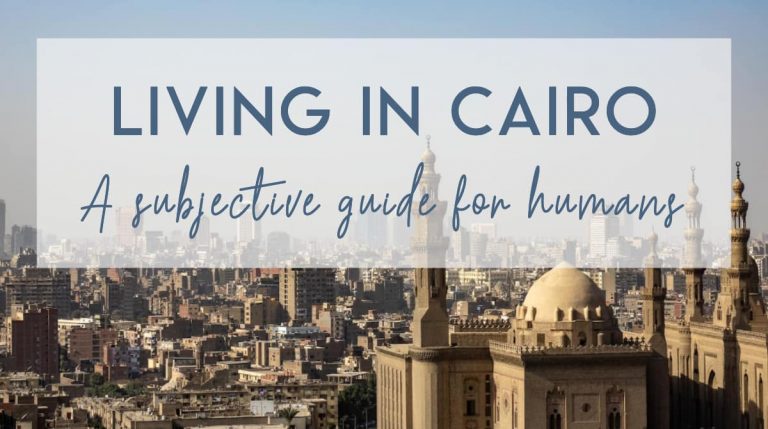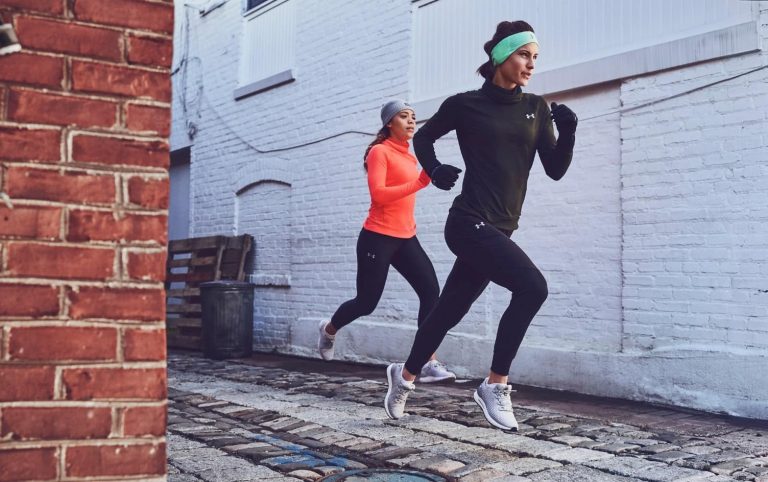Cube MMA Review — MMA Training in Seoul, Korea
For three months in late 2022, I trained in MMA in Seoul, South Korea, at a local gym called “Cube MMA” (큐브MMA in Korean), run by a very friendly coach named Kim, although I called him “Coach” or “Boss” in Korean until my last day.
The owner and head coach of Cube MMA is 김형광 (Kim Hyeong Gwang), though you should just call him 과장님 (gwajangnim), which means “boss”. That’s what most people called him.
Finding places to train in MMA or Jiu Jitsu in Korea is a little hard. You have to use Naver Maps (here’s Cube MMA’s Naver Maps “place”) to find anything, and information is rarely updated and almost never in English, so you need to search in Korean.
So, it was really hard to find where offers Jiu Jitsu (whether no-gi, gi, or whatever) and what schedules and pricing was. On top of that, Seoul is HUGE, and so you really have to find stuff in your area. Finally, no-gi training and especially MMA training is in its infancy in Korea — there are only a few gyms I found.
I originally planned on training at Korean Zombie’s gym, admittedly, because it had the most information online in English. But when it was flooded by the rains of 2022, I had to find an alternative. I’m really glad I did, because I love Cube’s culture and focus. I worked harder at Cube than I ever did in my life!
Here are my latest posts on combat sports gym reviews from around the world, vocabulary for training in other languages, and other resources. If you’d like to have me visit and see your gym, please contact me — I love visiting new places and making new friends through combat sports.

Quick background on me (for context)
I’ve been doing MMA / BJJ / Striking training for over a year now, nearly at 500 hours of training, with classes anywhere from 1-2 hours normally. I train 4-6 days a week. I have a blue belt in Brazilian Jiu-Jitsu but suffer from massive imposter syndrome, am in my 40s, and not likely to compete other than in friendly local comps.
I mostly train for the experience, to meet people in new places, to learn new things, and to be better than I was yesterday, rather than to compete or for self defence.
That’s all for context, but I’ll also talk about people who compete (even at the amateur level), younger folk, and those who can’t train as often, because I meet the whole variety while at any of these gyms.
Oh, and how is this relevant to “Discover Discomfort”? Well, I like to use things like sports to get to know people in other cities. It’s a way of meeting people and making local friends in other countries that doesn’t feel artificial. It’s just one of our suggestions of what to do, including other clubs and social activities.
Aside from that, I find martial arts / combat sports very difficult, so they present discomfort for me at the outset!
Overview of my experience training at Cube MMA
I really liked training at Cube MMA and definitely would again. I considered switching gyms once the one I originally intended to attend re-opened — but I was learning so much, enjoyed the training and coaching style, that I stayed.
By far, one of the things I liked most about Cube MMA was the coach. He was just such a good coach. I’ve had dozens of coaches over the years, for fitness through to language (well, teachers, but they acted like coaches), and martial arts, and this one was great — he always gave me just enough coaching to develop what I needed to learn to take me to the next level, and knew my strengths and weaknesses well. I really liked him.
The Cube MMA coach was encouraging, gentle, patient, and kind. Just a kind man. Can’t say this enough!
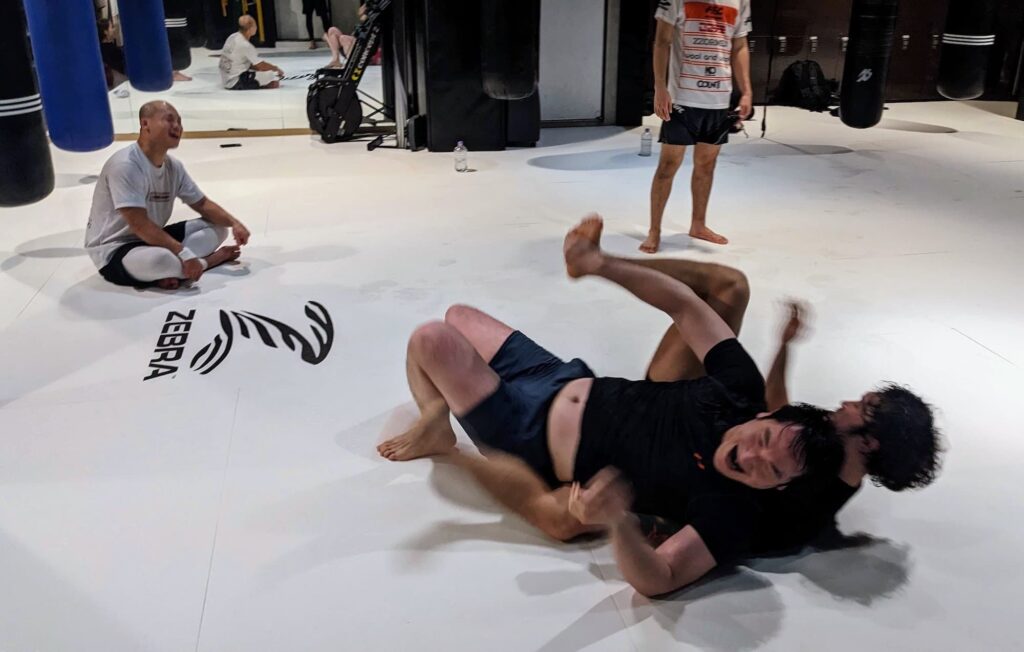
Cube has the whole spectrum of attendees, with roughly a third of us with no intention of competing, and the rest competing at anywhere from amateur to professional levels.
In Korea, “amateur” MMA uses shin guards, head gear, and boxing gloves. The pro levels use no protection other than MMA gloves and a mouth guard.
The competitors at Cube MMA are serious but friendly. I sparred with some of them — but I didn’t often spar with the professionals, partly as they get more out of sparring with each other, and partly as I don’t get a lot out of being totally demolished. So I mostly trained with amateurs and hobbyists of all levels.
Since Cube is an MMA gym, there are no “ranks”. Nobody has a belt of any colour. Before rolling with someone, I would see their stance and how they’d move, and kind of assess their level.
Also, the first time sparring with anyone, if I don’t know them I’ll say something like “It’s our first time sparring, so let’s go easy”. I think this is good practise when visiting a new gym (here are all my tips on the first time you visit a new gym).
The only thing I didn’t like about training at Cube was the fact that classes are evenings, only. But I know that to train in the daytime is a luxury.
Most people have 9-5 schedules of work or study. It’s only in the bigger gyms that you can train in the daytime, and even in those, the day classes are often less busy and less content-rich than the evening ones.
Professional levels at Cube MMA
Cube MMA caters to everyone from amateurs (like me) to pros who fight regularly with nothing but MMA gloves, going all out!
And in the local circuits, Cube MMA’s competitors are pretty good, at everything from amateur to pro levels! They have their share of wins, impressive considering the small size of the gym.
Here’s a fight from the local Black Combat amateur competition you can watch. It was all over in a hurry! You can search for 큐브MMA on Youtube for more bouts.
I had the honour of sparring with some of these guys at our local gym (including the one in the video above) and they’re fun and gentle with rookies. It’s pretty cool to spar with pros, and not something I have experienced in most gyms.
Content — What you Learn at Cube MMA
Cube MMA is an MMA gym. There are no gis / kimonos. And every class bleeds into others.
So very few people at Cube train in just one thing (e.g. boxing). Even though an evening session is broken up into parts, they tend to mix up — e.g. a striking class may be ground and pound, or may involve tackling as part of combinations.
There are four things you learn at Cube MMA:
- Striking (kind of Muay Thai / Kickboxing-style, but definitely including elbows and knees)
- Grappling. There’s no “Gi” style. This includes wrestling-style movements and takedowns and even some Judo
- MMA (combining the two)
- Conditioning, very bodyweight focused, aiming to build endurance.
In the time I was there in 2022, the schedule was very roughly:
- 6:30-7:30: Striking
- 7:30-8:30: Grappling
- 8:30 onwards: Some more rolling, and also conditioning
This schedule tended to vary with the season and also with whatever was happening around the gym. For example, in competition season, there might be more of a focus on training in MMA-style combos, like attack / defence against the cage wall.
Striking sessions were very athletic, but always skill-focused. In a class, we might work on a few techniques or combos, and then drill them with a partner or with a bag. The combos spanned the whole gamut, including elbows and knees, but we’d always just drill very lightly with partners (other than the pros, whose “thwacks” I would wince at from across the room).
Training style
The training style is quite physically intense at Cube MMA. I’d do two to two and a half hours of training a day and would leave before others, who’d stay on for another hour of conditioning!
The coach would always give us specific coaching in techniques in both the striking and grappling components. He’d show us something a couple of times, and then get us to practise it with each other, or on bags sometimes.
I was pleased to see quite a lot of sparring in both the striking and grappling components. I’ve done a lot of grappling sparring, but never have sparred in striking. It’s REALLY fun. I got hit in the face/eye a lot, and really learned to keep my guard up and strike defensively. Oh, I mean, I learned a little bit. I actually just learned how much I have still to learn.
The joy of striking sparring is that it is quite psychologically challenging to be able to look head on at an opponent interested in hitting you… and advance on them. It challenges me on many levels. There are lots of idioms that come from boxing, and it’s satisfying to be able to relate to them on a personal level.
Culture / Community At Cube MMA
As a smaller gym, most people there know each other and have been training together for years. This is not just the athletes — it’s also the more casual members.
Even though I worked hard on learning Korean, I never go to the point where I could just chit-chat with members, so I never got to know anyone very well. But I had friendly chats with most members from the amateur to the pro levels.
By and large, most people at Cube MMA are very friendly, always greeting me with a smile and going out of their way to give me a bow of acknowledgement. I felt very welcome!
On women — There were just two women athletes I trained with at Cube. One, Ina, was a regular, and the other, whose name I don’t know, wasn’t so regular. There was also the girlfriend of one of the athletes who trained there, but she was more casual. So really, I’d say just one regular woman athlete.
Luckily, she was awesome! I was awestruck at her level for just training for one year — she had really solid game. If you’re a petite woman, you’ll probably end up training with her.
And on foreigners — for the first month, which was a warmer month and also the time when another nearby gym was closed, we had a few foreigners there. But for the second and third month I trained at Cube MMA, there were no other non-Koreans. I was the only one. This was both intimidating and also challenging!
Do you need to speak Korean to train at Cube?
If you don’t speak Korean, you’ll struggle to learn much at Cube MMA.
I don’t speak MUCH Korean, but I learned enough to understand instructions like
- How to do basic grappling manoeuvres and striking combos (many words are loan words, but I had to learn a lot of verbs and body parts in Korean)
- Instructions on how to train, like “Grab a partner and a bag, do this for 40 seconds, then this for 20 seconds”
The coach and half the athletes don’t really speak much English. They can make themselves understood if needed, but it’s a hindrance and would obstruct training.
So, I’d highly recommend you have at least A2 level Korean to train at Cube.
That said, if you plan on just dropping in, English and Google Translate will be fine.
Physical environment
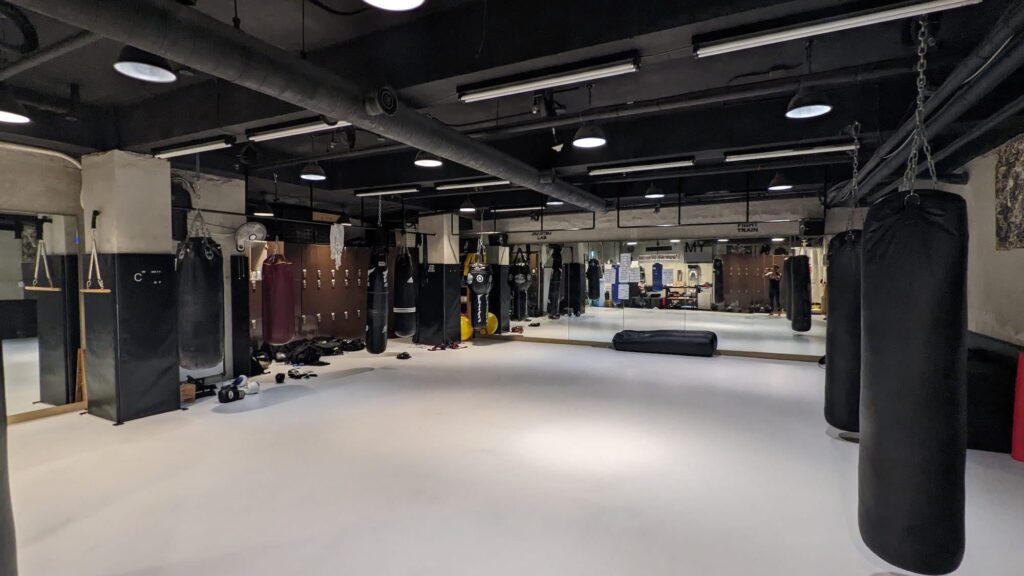
Like many modern gyms in Seoul, where space is at a premium, Cube MMA is quite small — but it never felt too small.
It’s on the basement level, accessible from the street. I’m always a bit worried about basement gyms as they can sometimes be flooded out! But it never was.
There are two parts to the Cube MMA training facility: the upstairs big training room and the downstairs box with padded walls.
Upstairs is where most classes took place. It’s a big, open space. But sometimes we went downstairs to train against the wall and do grappling sparring in preparation for competition. Downstairs was more intense.
I don’t have photos of the downstairs space, but it’s a very clean room with blue padded walls, and enough space for 2-3 training partners to go at it.
There are separate male and female bathrooms / change rooms. The male one is mostly a big shower block, communal style showering, so be comfortable with that! (It’s something I had to learn to be comfortable with in France, where people would just chat with me in the shower… I admire that level of comfort with nudity, but it’s not the way I grew up, so it’s a bit hard for me.)
In the Korean one though, there’s rarely more than one person in the shower at a time. There are two hair dryers even in the male changing room — Koreans take grooming seriously!
Pricing and Location
It took me a couple of gos to find Cube MMA, but it was a new part of the city (and a new city, really) for me. But this Google Maps location is accurate.
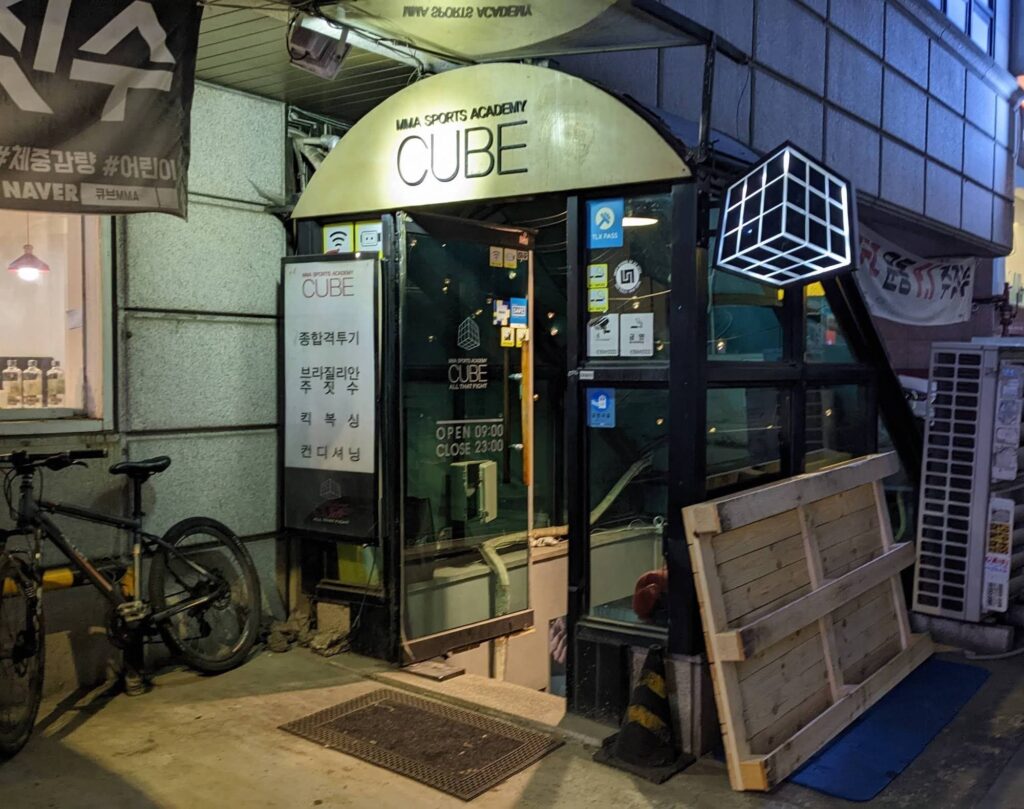
Pricing varies depending on how long you’re staying, but you can expect to pay a maximum of 300,000 KRW per month for unlimited training. At time of writing this is 230 USD per month — which is pretty expensive for training anywhere in the world.
They sell very limited gear at Cube MMA. I bought a pair of new boxing gloves while there (my old ones were falling apart), but they didn’t have MMA gloves. I do think they have wraps.
Wrap up
I really enjoyed my time at Cube MMA and would definitely go back! Maybe once I’m a bit better… or a lot better…
Next stop was Echo Park Boxing in Los Angeles, USA.

